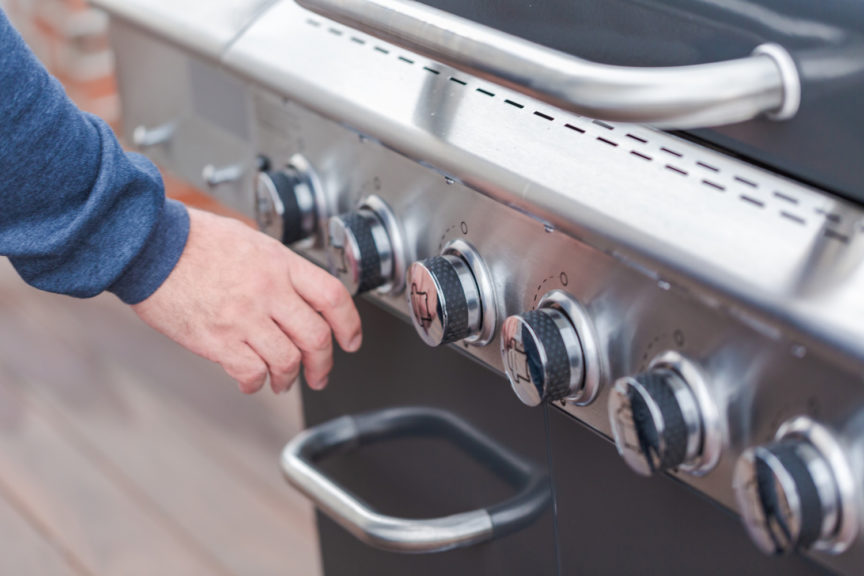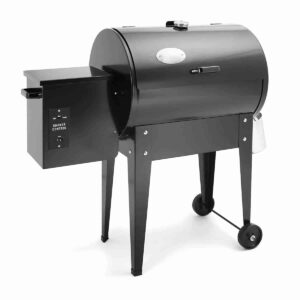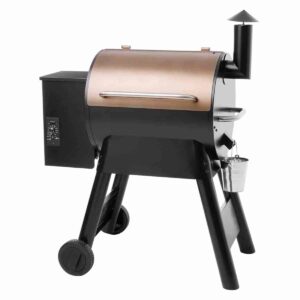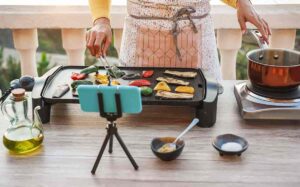There is almost nothing more fun or fulfilling than firing up the grill on a hot summer day and throwing on something delicious for dinner. Unfortunately, things do not always go as planned. It is a disappointing feeling when you turn that grill on and see that there is no flame or ignition. What should you do next?
There are several reasons you propane grill might not be getting gas, and we highlight them in this article. Most problems have easy solutions. You do not have to be an expert to perform simple tests that will tell you what is wrong with your grill or rule out things that are not wrong with your grill.
Why is my grill not getting gas? Reasons your grill is not getting gas may include and empty propane tank or a clog in your gas line. It is also possible that the pressure between your tank and grill needs to be equalized.
You could have a faulty regulator and may need purchase a new regulator (link to top rated regulator on Amazon). If your regulator is freezing up, make sure to check and see if your tank is overfilled or tilted. This could be the cause of the problem.
Most every home has a grill. These appliances are not something to be feared. You can easily test for problems on your own without calling in professional help or discarding your grill.
There are different reasons gas may not be reaching your burners, but don’t worry. We will walk you through how to perform simple test that rule out problems one by one until you have come up with the fix for the grill.
Why Is My Grill Not Getting Gas?
If your propane grill is not getting gas, the first things to do is to check and make sure your propane tank is not empty. Typically you can pick up a tank and if it’s unreasonably light that’s a good indication it’s empty. Fuller tanks are much heavier.
Ok, with that out of the way let’s go into the steps of what to do if your grill isn’t getting any gas.
If your grill isn’t getting any gas, follow these steps:
Shut the valve on the propane tank
Make sure all valves are shut and all knobs are turned to “off”
Disconnect your gas hose from the tank and the grill
Reconnect your hose to both the tank and the grill
Open the valve on the tank
Use soapy water at the connections to see if you have any leaks
If there are not any leaks, turn the grill back on
Before you do anything, it is very important to make sure you have turned all of the knobs on your grill and your shut off valve to the “off” positions by turning them in a counterclockwise motion.
You can present a danger to yourself and anyone around you if you do not properly make sure the grill is turned off and there are no open outlets for the gas to come out of on any part of the grill.
The first thing to consider when working on your grill is safety. Do not get lax about turning your burners and your shut off valve to their “off” positions. Grills are a fairly safe appliance to use, but gas can be dangerous if you do not take the correct steps and proceed with caution.
Gas has explosives qualities, and you would not want to burn yourself or any of the people who may be around you.
Chances are, if your tank is not empty, then either you have a gas leak, or you need to equalize the pressure between your tank and your grill. To detect a leak, fill a spray bottle with soapy water. Spray the soapy water onto the gas line and the connections to both your grill and to your tank. The soap will bubble up if you encounter a leak.
If you have found a leak when you spray soapy water onto the connections, it is time to buy a new hose or a new connector. If there is no leak, this process has most likely served to equalize your pressure.
You can turn your grill back on and begin cooking. Hopefully taking these steps has fixed your problem and you are once again getting gas to your grill for cooking purposes.
If your grill still will not come on, your problem could be a sticky regulator. Change the hose out that runs from the tank to the grill. If you are still not getting gas, then you need to replace your regulator (link to Amazon). It is also wise to check for leaks around the nozzle of your propane tank.
Regulators are inexpensive and easy to replace. This is something you can easily do yourself without the help of a professional.
Once you have purchased a new regulator, pull the old one off. Take the new regulator, and carefully thread it onto the line coming from the propane tank. Is should fit snugly when you are finished.
Why Does My Gas Grill Regulator Keep Freezing Up?
Propane regulators often become covered in frost during normal use of your grill. This can signify an actual problem, it is usually just a sign that the outside humidity is high.
The vapors inside the regulator are extremely cold, so it is normal for condensation to occur on the outside of the propane grill regulator. This is usually nothing to worry about.
Once the grill is in use, the liquid propane in the tank starts to boil. The vapor, as it is boiled of the top of the liquid begins to make its way to the nozzle and line, where it will go up into your grill and be used for fuel.
The regulator reduces the pressure of the gas, so that it is usable. As the propane goes through the regulator, it expands, resulting in very low temperatures. This creates a cold atmosphere inside the regulator.
When this happens, the super-cooled gas in the regulator meets with the humidity outside and causes the regulator to frost over. This is nothing but condensation, and should not cause any worry.
Here are two reasons your regulator might freeze up that should cause concern:
- The container is overfilled
- The tank is not upright
If the container is overfilled, this is causing extremely high pressure within the regulator, and the gas is chilling to even colder temperatures than usual. If this is the case, there does not have to be as much humidity in the air to cause freezing, and you might notice a frozen over regulator even if the temperature outside is fairly low.
If the tank is not upright, the service valve cannot communicate properly with the vapor space of the container. Thankfully, both of these problems are easy to fix. Simply make sure your propane tank is completely upright and that it is not overfilled. Anyone can easily troubleshoot either of these two problems.
If there is a clog in your gas line, this can also cause your regulator to freeze up or not work properly. Try changing out the line and see if it makes a difference. If it does not, the problem was not in your gas line, and you may have a faulty regulator.
New gas lines are inexpensive and easy to install. This is an easy test to perform to see if you did have a clog in your propane line.
How Do I Reset The Regulator On My Gas Grill?
While using a gas grill, it is very common to have some issues with the gas regulator at one point or another. While this can be a tedious task to deal with, it is not a very complicated one.
If the bypass valve in the propane regulator is stuck, you will probably hear some sputtering, and you will not be getting adequate gas to your grill. You may see your burners light up for a second, but the fire will quickly die back down. There will not be enough flame to actually cook anything.
If you ever find yourself in a situation where you need to reset the regulator on your gas grill, you can follow along with the simple steps that are outlined down below.
Here are the steps to resetting the regulator on your gas grill:
- Open the lid on your gas grill
- Turn all burner dials to “off”
- Disconnect the regulator from the propane tank
- Open the burner knobs to “on”
- Wait 30 seconds
- Reattach the regulator
- Open the propane shut off valve
Make sure the lid to your grill is open. You want to be able to see your burners and make sure that there is no gas escaping from anywhere. You also want plenty of airflow in the case that gas is escaping from somewhere.
Avoid putting your head underneath the lid as you work. You would not want to accidentally inhale fumes and make yourself sick or pass out.
Before you try and reset your gas grill regulator, be sure all dials are turned to “off”. Then disconnect the regulator from the propane tank. It should simply pull off. Turn the burner knobs back to “on” and wait 30 seconds.
During this time, the regulator should reset itself. It is designed to do this. Reattach the regulator by threading it back onto the line running from the tank. Open the shut-off valve.
If you are still not getting gas to your grill, chances are the regulator was not your problem. This is an easy problem to check for, and worth doing before you contact a professional or purchase another grill.
If the problem was not with your regulator, then you probably either have a leak, a clogged hose, or an empty propane tank. Again, these are all easy fixes, so don’t worry!
What Does a BBQ Gas Regulator Do?
The regulator is there to ensure that the pressure of the gas is where it should be before it hits your grill burners. If it were not for the regulator, gas would hit your grill burners with such pressure as to cause flare up and danger to anyone who might be in the vicinity. Flames would shoot up out of the burners with shocking speed.
Avoiding flare ups may have been the reason you chose a gas grill in the first place, as charcoal grills are more known for this phenomenon.
As you can see, the regulator is an important and necessary piece of equipment, and you should always make sure it is working correctly. It would be dangerous not to. The regulator is the grill’s key safety feature.
Here is what is going on within your gas grill regulator:
- As the gas in your tank reaches the boiling point, the vapors travel to the top of the tank
- The liquid remains near the bottom of the propane tank
- The vapors pass through the regulator
- The regulator suddenly decreases the pressure to an acceptable amount
- This causes the vapors to expand rapidly
- This cools the vapors to subzero temperatures
Once you turn on your gas grill, the gas tends to get really hot. In fact, it begins to boil. As the gas boils, the vapors rise above the liquid, traveling to the top of the tank.
Before they can exit the tank and make it to the burners on your grill, the vapors have to pass through your gas grill regulator. This is in order to lower the pressure with which the vapors are traveling.
The regulator’s job is to decrease the pressure of the gas, so it does not send a flame of flare shooting out of your grill and your grill maintains an acceptable temperature. As the pressure of the gas is decreased, it naturally cools to subzero temperatures.
If there is high humidity outside, this may result in the freezing up or frosting over of your regulator. This is simply condensation at work.
Once the regulator has decreased the pressure to an acceptable level, the vapors are allowed to travel through the rest of your line until they come into contact with your grill burners. This is the good part! Once the gas has reached your burners, you are literally, “Cookin’ with gas!”
Are All Propane Gas Regulators The Same?
All propane regulators are not the same. There are single hoses and regulator kits, and then there are single or two stage regulators. Below, we describe which kit you need, depending on how many BTU’s your grill puts out.
BTU is the key word here. BTU stands for British Thermal Unit. The type of regulator you need will depend on how many BTU’s your grill puts out. Hoses correspond to the regulator, so it is also necessary to know how many BTU’s your grill is putting out in order to choose the right hose for your propane grill.
Here are ways to tell which kind of regulator you have and what parts go along with it:
- Look at the information sticker on your grill
- Be sure to add all of the BTU’s up to calculate total BTU’s
If your grill has under 60K BTU’s, you would need to use a simple hose and regulator kit. If you grill has more BTU’s than this, you may need a single or two stage regulator. Built-in grills are made for using a stainless steel flex hose and no regulator at all. You should never use a rubber hose with a built-in grill.
Gas grills are not all that complex. If you are having trouble getting gas to your grill, chances are, there is no reason to contact a professional or purchase a new grill. You are probably capable of troubleshooting the problem yourself. First, check to make sure that you have propane in your tank. This is the easiest problem to fix.
If you do have propane, the next step is to do a leak test and a pressure equalization test. We have explained how to do the leak test with a spray bottle of soapy water. The pressure test is also easy to conduct and begins with simply disconnecting your hose.
If your problem is still not fixed, it may be time for a new regulator. We have explained the different types of regulators and which types of grills and hoses they should be matched to.
Once you have determined your problem and applied the easy fix, it’s time to start grilling again! Summer is just around the corner. It is grilling season. The time for pulling out your grill and making sure it is in perfect working order is now!
Now that you know how to troubleshoot your grill not getting gas, you can once again enjoy that hot summer day grill-out you have been looking forward to. It’s time to throw some hotdogs or hamburgers on the grill, crack open a beer, and enjoy yourself.
With the help of all the tips that you have learned throughout this article, you can take pride in knowing that you have fixed the grill on your own, and now you are prepared next time things do not light up as they should for a quick solution to a simple problem.
Check out our Recent Posts
Z Grills Review
If you’re looking for a grill that will last, Z Grills is the way to go. Z grills are made of the best quality materials...
Read MorePit Boss Pellet Grill Review
Pit Boss is one of many when it comes to manufacturers of wood pellet grills and smokers. If you have spent any amount of time...
Read More10 Fun Benefits of Taking an Online Cooking Class
There’s never been a better time to take an online cooking class. With the continued popularity of online learning, there are more and more exciting...
Read More



